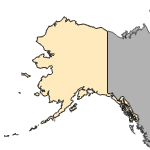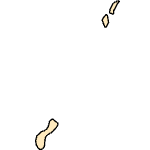Afrixalus fornasini
(Fornasini's Spiny Reed Frog)
Amphibians-Frogs
Exotic |
|
Common name: Fornasini's Spiny Reed Frog
Synonyms and Other Names: Greater Leaf-folding Frog
Taxonomy: available through
www.itis.gov
Native Range: Southeastern Africa, Kenya, Malawi, Mozambique, South Africa, Tanzania, and the United Republic of Zimbabwe (Krysko et al. 2011).



|

Alaska |

Hawaii |

Puerto Rico &
Virgin Islands |

Guam Saipan |
Hydrologic Unit Codes (HUCs) Explained
Interactive maps: Point Distribution Maps
Nonindigenous Occurrences:
Table 1. States with nonindigenous occurrences, the earliest and latest observations in each state, and the tally and names of HUCs with observations†. Names and dates are hyperlinked to their relevant specimen records. The list of references for all nonindigenous occurrences of Afrixalus fornasini are found here.
Table last updated 12/4/2025
† Populations may not be currently present.
Ecology: Afrixalus fornasinii lives in the savanna, possibly preferring dense savanna with larger bushes and trees. It is found in the coastal lowlands, but can be found up to 1,300 m in elevation. To the south, it is confined to coastal tropical lowlands of South Africa. Moist savannah, bush land, grassland, and dry forest are inhabited. Breeding occurs in permanent and semi-permanent pools, and marshes with reeds and sedges. (Pickersgill et al. 2004; AmphibiaWeb, 2012). Breeding begins in late September, and large choruses have been recorded in December and January. During the breeding season, A. fornasinii inhabits stagnant water bodies containing large stands of saw grass (Cyperus immensus) and cattails (Typha latifolia). Males may call from elevated positions on sturdy, broad-leaved vegetation or from reeds; calling begins shortly after sunset and continues until around midnight. The call consists of an initial vibrating pulse followed by a rapid stutter. It has been compared to the sound of a small machine gun (Harper et al. 2010; Encyclopedia of Life, 2012a).
Eggs are laid over permanent water on reeds that are folded and glued over the eggs. Clutches contain approximately 80 unpigmented eggs. Hatching occurs 5 to 10 days later. The tadpoles are long and slender with flattened heads and a total length reaching 65 mm. The larval stage can last 75 days (Encyclopedia of Life, 2012a).
Means of Introduction: Pet trade.
Status: Presumably failed in Florida.
Impact of Introduction: Unknown. It has been reported that A. fornasini preys on eggs and developing larvae of other frogs (Drewes and Altig, 1996).
References: (click for full references)
AmphibiaWeb: Information on amphibian biology and conservation. 2012. Berkeley, California: AmphibiaWeb. Available from: http://amphibiaweb.org/. Accessed 1/1-13/2012.
Channing, A. and K. Howell. 2006. Amphibians of East Africa. Cornell University Press, Ithaca, NY. 418pp.
Drewes, R.C. and R. Altig. 1996. Anuran egg predation and heterocanibalism in a breeding community of East African frogs. Tropical Zoology 9(2):333-347.
Encyclopedia of Life. 2012. Afrixalus fornasini. Encyclopedia of Life. Accessed 8/12/2012 at: http://eol.org/pages/337448/details.
Harper, E.B. G.J. Measey, D.A. Patrick, M. Menegon, and J.R. Vonesh. 2010. Field Guide to Amphibians of the Eastern Arc Mountains and Coastal Forests of Tansania and Kenya. Camerapix Publishers International, Nairobi, Kenya.
Krysko, K.L. and 12 others. 2011. Verified non-indigenous amphibians and reptiles in Florida from 1863 through 2010: Outlining the invasion process and identifying invasion pathways and stages. Zootaxa 3028:1-64.
Pickersgill, M., A. Schiøtz, L. Minter 2004. Afrixalus fornasini. In: IUCN 2012. IUCN Red List of Threatened Species. Version 2012.2. <www.iucnredlist.org>. Accessed 3/5/2013.
Author:
Fuller, P.
Revision Date: 4/17/2019
Citation Information:
Fuller, P., 2025, Afrixalus fornasini (Bianconi, 1849): U.S. Geological Survey, Nonindigenous Aquatic Species Database, Gainesville, FL, https://nas.er.usgs.gov/queries/FactSheet.aspx?SpeciesID=2866, Revision Date: 4/17/2019, Access Date: 12/4/2025
This information is preliminary or provisional and is subject to revision. It is being provided to meet the need for timely best science. The information has not received final approval by the U.S. Geological Survey (USGS) and is provided on the condition that neither the USGS nor the U.S. Government shall be held liable for any damages resulting from the authorized or unauthorized use of the information.